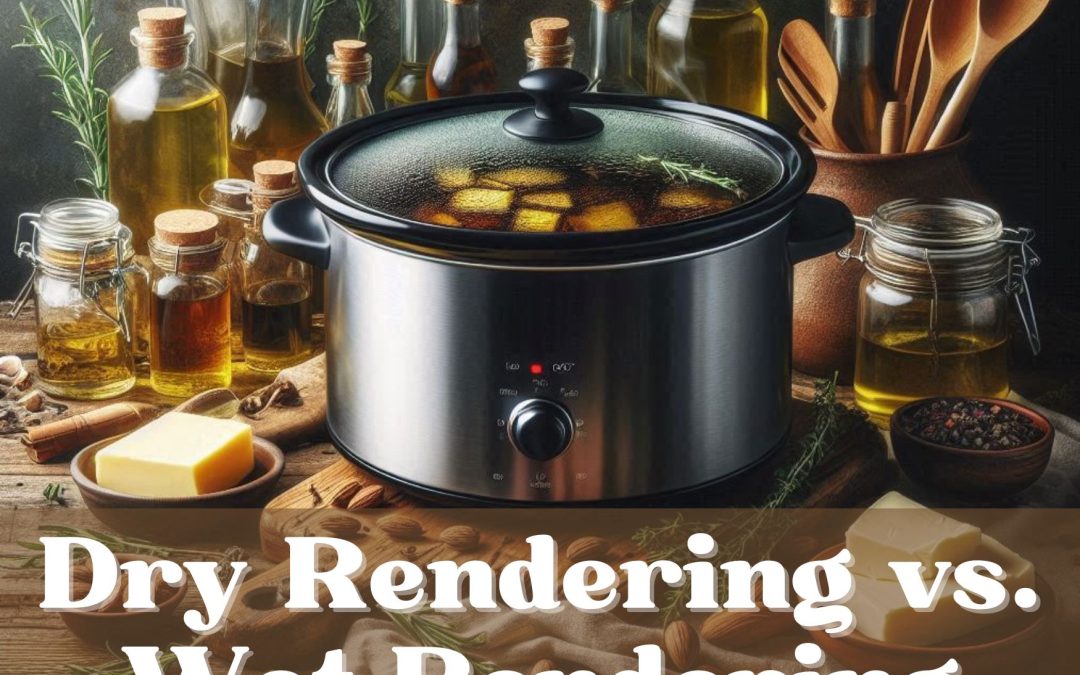This post may contain affiliate links, to learn more about them, check out our Disclosure.
Tallow, a form of rendered animal fat, is valued for its versatility in cooking, skincare, and even candle-making. Rendering tallow can be done using two primary methods: dry rendering and wet rendering. Each method has its unique benefits and drawbacks, depending on the intended use of the tallow. Today we are explaining the differences between dry rendering and wet rendering tallow, along with the pros and cons of each method.
What is Tallow?
Tallow is rendered fat typically derived from cattle, goats, or sheep. It is solid at room temperature and has a high smoke point, making it ideal for frying and cooking. Additionally, tallow is a popular ingredient in natural skincare products due to its moisturizing properties.
Dry Rendering Tallow
Dry rendering involves cooking the fat without adding water. The fat is chopped into small pieces and then slowly heated in a pan or oven. As the fat heats, it melts and separates from the solid connective tissues, which are eventually strained out, leaving behind pure tallow.
Pros of Dry Rendering:
Higher Purity:
- Dry rendering produces a very pure form of tallow because no water is used in the process. This is particularly beneficial for making skincare products or high-quality cooking fats.
Longer Shelf Life:
- The absence of water in the rendering process results in tallow that is less prone to spoilage, extending its shelf life when stored properly.
Simpler Process:
- Dry rendering is straightforward and requires minimal equipment, making it accessible for those new to tallow rendering.
Cons of Dry Rendering:
Requires Close Monitoring:
- The fat can easily burn if the temperature is too high or if it’s not stirred regularly. This requires careful attention during the process.
Less Yield:
- Dry rendering may yield slightly less tallow compared to wet rendering, as the process doesn’t extract as much fat from the connective tissues.
Wet Rendering Tallow
Wet rendering involves cooking the fat in water. The fat is placed in a pot with water and heated until it melts. The fat separates from the water and rises to the top, where it can be skimmed off or allowed to cool and solidify. The remaining water is discarded, along with any impurities that settle at the bottom.
Pros of Wet Rendering:
Cleaner Process:
- The addition of water helps prevent the fat from burning, which can result in a cleaner and more neutral-smelling tallow.
Higher Yield:
- Wet rendering typically extracts more fat from the connective tissues, resulting in a higher yield of tallow.
Less Monitoring Required:
- The water in the pot acts as a buffer, reducing the risk of burning the fat. This allows for a more relaxed rendering process.
Cons of Wet Rendering:
Longer Process:
- Wet rendering can take longer than dry rendering due to the need to separate and cool the fat from the water.
Shorter Shelf Life:
- The presence of water in the rendering process can introduce moisture into the tallow, potentially leading to a shorter shelf life if not properly stored.
Potential for Off-Flavors:
- If the water used in the process isn’t filtered or if impurities aren’t properly removed, the resulting tallow may have a less desirable flavor.
Dry Rendering vs. Wet Rendering: Which is Better?
The choice between dry rendering and wet rendering tallow depends on your specific needs and preferences:
- For Cooking:
- Dry-rendered tallow is ideal for cooking due to its purity and longer shelf life. It has a clean flavor and is less likely to spoil.
- For Skincare:
- Dry-rendered tallow is often preferred for skincare products as it’s pure and free from any potential moisture that could affect its stability.
- For Higher Yield:
- If maximizing the amount of tallow produced is important, wet rendering is the better option. The process allows for more fat to be extracted, though it may require additional steps to ensure a clean final product.
Both dry rendering and wet rendering tallow have their own unique advantages and drawbacks. Dry rendering is praised for its purity and simplicity, making it a top choice for high-quality cooking and skincare applications. Wet rendering, on the other hand, offers a higher yield and is less prone to burning, though it may result in a slightly shorter shelf life. By understanding the differences, pros, and cons of each method, you can choose the one that best suits your needs, whether you’re making tallow for cooking, skincare, or other purposes.

